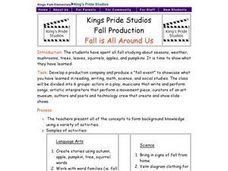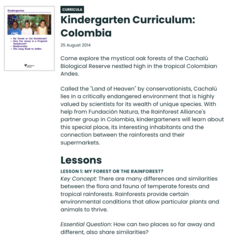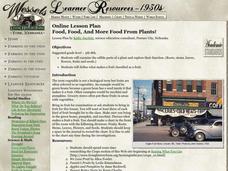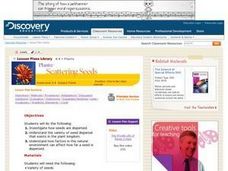Curated OER
Pumpkins, Pumpkins, Pumpkins
Students identify and interpret the lifecycle and parts of the pumpkin. Students utitlize interactive ways to discover this process. Students create a big book of their own by researching further information about pumpkins and what...
Curated OER
Fall vs. Spring
Students compare fall and spring. In this seasonal changes lesson, students read the book Apples and Pumpkins and discuss the fall season. The students then read It's Spring and describe the spring season. As a culminating activity,...
Curated OER
Pumpkins By the Pound
Use pumpkins of various sizes to experiment with weight and perimeter. First the class lifts the pumpkins one by one, estimating each pumpkin's weight. They arrange the pumpkins from lightest to heaviest, and then string weigh each one...
Curated OER
Fall is All Around Us
Students develop and create a production company and produce a fall event that demonstrates what they have learned in various subject areas. STudents create stories, complete a venn diagram comparing fall and summer, graph and measure...
Curated OER
Fall vs. Spring
Students learn about fall and spring by engaging in hands-on activities in order to fulfill science and language arts standards. In this lesson on seasons, students first listen to a story about fall, discuss the characteristics of the...
Rainforest Alliance
My Forest or the Rainforest?
The differences between tropical and temperate rainforests range from animals and flowers to climate and landscapes. Kindergarteners compare and contrast characteristics of their local forest to a tropical rainforest.
Curated OER
My Forest or the Rainforest?
Students explore the flora and fauna of temperate forests and rainforests. They examine the environmental conditions that allow certain plants and animals to live in the rainforest.
Curated OER
Eat Your Vegetables Challenge
In this healthy diet worksheet, students read the statements about vegetables and select the answer that best complete the 11 statements.
Curated OER
Bee Pollen Popular
The world would be a much different place without the help of pollinators. Read about the important role bats, hummingbirds, and various insects play in plant reproduction, exploring the interdependence of living things in an ecosystem....
Curated OER
Food, Food, And More Food From Plants!
Students examine the edible parts of a plant and explore their function. They define what makes a fruit classified as a fruit. They create a sketch or map or photo of a 1930s farm and justify their plant selections.
Curated OER
Plants: Scattering Seeds
Students collect and microscopically examine seeds from the school yard and neighborhood. In small groups, they draw and discuss the shapes of the seeds to determine each plant's method of dispersal. they also test two types of seeds...
Curated OER
Spring Bulletin Board
Students create a Spring bulletin board. Students color and cut out frogs and attach them to pipe cleaners. The frogs then bounce and move. Students discuss frogs and how tadpoles become frogs.
Curated OER
Solar Energy - Dehydration
Sixth graders explore process of drying food using solar energy. They cook and/or dry food such as pumpkins, watermelon, corn, and deer meat, explain how solar energy changes foods, and compare and contrast solar energy with other forms...
Curated OER
Life Cycle of a Frog
Students work together to explain and illustrate the life cycle of a frog.
Curated OER
Fall vs. Spring
Students compare and contrast the seasons of fall and spring. In this fall and spring lesson plan, students learn the differences between fall and spring through books and pictures, identify the differences, draw their own pictures, and...
Curated OER
Harvest Happenings
Learners explore the history of agriculture and develop a personal connection to agriculture. Students investigate how farming practices have evolved through the years and create poetry relating to harvest.
Curated OER
Mammals And Reptiles
In this animal worksheet, 3rd graders study the aspects of the different animal classifications of mammals vs. reptiles. Students cut out 8 animals and paste them on the chart in the correct category.
Curated OER
Where Do They Grow?
Students complete worksheets. In this fruits and vegetables lesson, students complete a worksheet on where fruits and vegetables grow where they draw connecting lines. Students color fruits and vegetables on a worksheet.
Curated OER
Garden Starters
Students grow their own gardens. In this planting lesson, students use egg cartons to start their own gardens by planting and caring for seeds. A game, a song, a craft, and a recipe are all included with the lesson to complement the theme.
Curated OER
Ice Eggs
Students melt colored ice cubes which are created from a funnel, balloons, water, and food coloring. In this ice lesson plan, students put food coloring into water in a balloon, freeze it, and see how the food coloring ended up making...
Curated OER
Observing and Discovering Using Our Senses
Third graders decide if it is possible to identify something using only the senses of taste, smell and hearing. They listen to a CD of animal sounds with their eyes closed and attempt to identify the animal. Next, they smell an air...
Other
Arbor Scientific: Haunted Laboratory: Halloween Physics
This resource presents a collection of experiments for the science classroom that focuses on physics concepts for Halloween. Activities include mirror ghost with a concave mirror, apple oscillators with pendulums, and a pumpkin pendulum....























